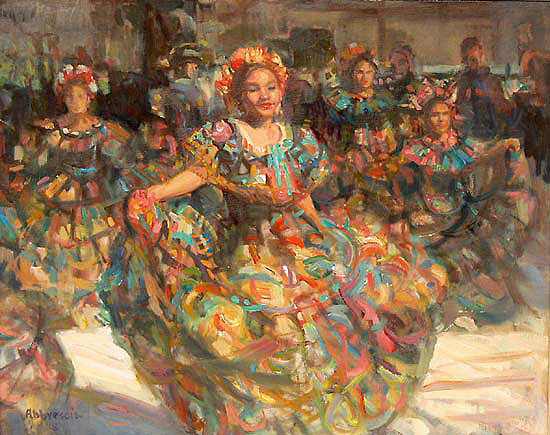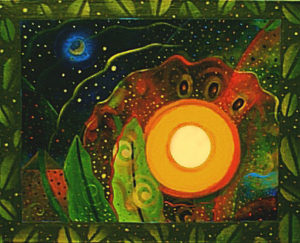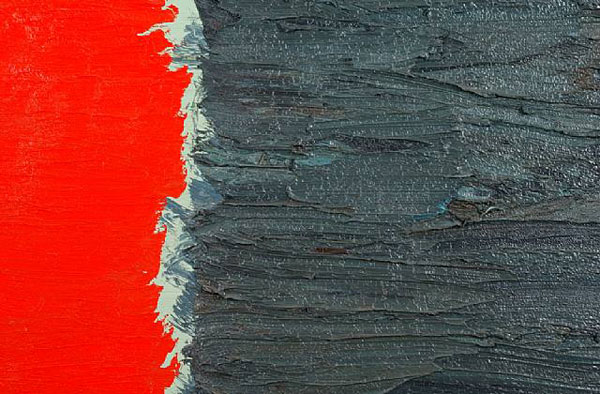Dear Artist,
Painters paint, writers write, and sculptors make a lot of chips. No matter what our disciplines, these are the facts of successful creativity. Today I’d like to go a little deeper into the “doing” part of what we do. It’s about the basic unit of our work.
The “art unit” is a piece of art, finished and signed. It’s the best you can do today. It isn’t the motif, the stroke or the passage. It isn’t the word, the phrase, the idea, or the plot — it’s the job. Without the whole art unit there’s only play. Play’s okay for its own sake, but it’s most valuable to score. Scoring renews creativity — it resets the muse-clock. Art units ideally spring from desire — like a child much wanted and anticipated. But not always. Creative birthing is a slippery business. You have to know that I’ve got a few ideas that you might find useful:
Prime your pump with a steady march of reference. Three or four ideas or motifs in line are about right for most creators. Motifs take time to germinate so you need a sub-plot of regular planting. Be prepared to fertilize at any time — even when your studio is dark. When coming into your zone the operative words are “exercise” and “process.” Even before Yoga or Pilates you need to limber up with squeezed paint. The machines of your exercise are the work easel and the study easel. Move around a lot. Cross pollinate. Reconsider. Finish. Sign. Your process is precious.
Over the past year it seems that dozens of artists have written something like, “I don’t have a lot of time so what’s your all-time best tip?” My answers varied depending on how I was feeling and what I was up to, but here, I think, are a few of the best:
Be your own best coach, and follow her advice.
Keep busy while waiting for something to happen.
Let yourself fall in love with your processes.
Process wild dreams quickly and efficiently.
Teach yourself to think several things at once.
Treasure your idiosyncrasies and foibles.
Finish that one — then get on with the next.
Know that to begin is often better than to think.
Trust your quick muse and your snap decisions.
Never leave your easel empty.
Best regards,
Robert
PS: “It is one thing to reject the coaching of others–that can certainly be wise. But to reject your own counsel? That has to be very close to cowardice.” (Eric Maisel)
Esoterica: The art unit is something you can live in. It’s private, unique, and it’s you. It’s both your love and your ego made visible. It may seem as if you are producing a commodity, but it’s actually a creative tool. By finishing, you harvest and clear the ground for your next. The art unit makes it possible to continue your life. Among my all-time best tips is the one I call MAD. It means “Make A Delivery.” Deliver your art unit.
Validation by selling?
by Susan Roe Roessner, Basking Ridge, NJ, USA
Since I have not sold any paintings yet, does that mean I have not really made a delivery? I do truly seek validation by being chosen and purchased. Because I have not yet been purchased, might I be painting with no direction from myself as muse?
(RG note) Your deliveries need not be to commercial ends. There’s a whole world of charitable destinations that can also validate. Even gifts to friends and relatives can help validate and establish your turf. Seek to serve with your art, and your art will begin to serve you. Serving stimulates the muse.
You need to know your stuff
by Helena Tiainen, Berkeley, CA, USA
One of the early best things that ever happened to me while a student at the San Francisco Art Institute was a teacher named Sam Tchakalian who told me during a crit: “You have no idea what you are doing.” This forced me into an emotional spill that made me figure out who I was and what was important to me. His somewhat cruel and unusual directness caused an immediate growth in me and the art that I have produced since then. I came to realize that one needs to know and love their craft. That one does not paint just for the look of it but for the feel of it. Artists need to spend time with their work — to get to know it. To listen and hear what it has to say about where it wants to go and then to proceed with bringing it to its fulfillment.
Cross pollination
by Mary Lapos, Danville, PA, USA
I’ve found that cross-pollinating is the best source of motivation for me. By that I mean I work in several different media at once. When things are slow on the canvas I start a collage that’s related in some way — or a watercolor — or a fabric piece — or I jump to another painting. In some way they all inform one another and enrich one another and ultimately get me to finish something. I’m patient — because forcing it causes a lot of bad work in the need or rush to get to the finished product.
Desire matters
by Coulter Watt, Quakertown, PA, USA
Motifs in conjunction with consistent style allow a painter to explore in depth, and create a body of recognizable work. That body of work is important because an individual becomes recognizable through those works and collectors get to buy into the series, a very important factor. Regarding the idea of desire — I paint for my home. That may sound strange, but it does two things: 1) It makes me think about living with the Art Units. 2) After selling a few paintings or stripping the walls for a show, those ugly, barren walls are inspiration to paint, fueling my desire to paint. Treasuring your idiosyncrasies and foibles is about self confidence, self trust, and a bugger all I’m doing as I please attitude. Never leave your easel empty — even if it’s a new, blank canvas. Make it easy to sit down and start painting at the drop of a hat. You also refer to MAD, “Make A Delivery.” Geez, I thought MAD stood for Motorcycle Anxiety Disorder, how foolish of me.
UFOs around the studio
by Sylvia Weir, Beaumont, TX, USA
As a fiber artist, it is almost a requirement that we have many pieces that are unfinished — affectionately known as UFOs. How many paintings do you have that are unfinished or is this a phenomenon peculiar to quilters and fiber artists?
(RG note) I’m a particularly flagrant example. I’ve a constant buildup of half finished canvases that have been dropped for one reason or another. Fiber artists suffer from what we call “swatch deficiency.” They live a life in which they are constantly short of a certain piece of fabric. Painters have the same problem. They need something that just can’t be found around the place at the present time.
Bedtime attitude
by Luc Poitras, Montreal, QC, Canada
Ernest Hemingway said, “At night, never go to bed without knowing what you’ll write tomorrow.” The spirit of that is applicable to producing the “Art Unit” — never go to bed without knowing what the next step is — that’s where you’ll start tomorrow. Trust in your process and it’ll get you there.
(RG note) Even if you don’t know how you’re going to fix it tomorrow, it’s great going to bed knowing that you will probably be able to figure it out.
Not doing
by John Gargano, Scottsdale, AZ, USA
For me, thinking is necessary, but it’s not doing. Sketching is part of the process, but it’s not doing. Procuring materials and tools and getting things set up are prerequisites, but they are not doing. Discussing concepts and exploring alternatives prime the pump but they are not doing. Selling, marketing, schmoozing and working on my web site are necessary support activities but they are not doing. Processing feedback from what you do is important, but again, its not doing. For me the only thing that constitutes doing is executing my work. And that, despite the merits of whatever I do at the moment or in a day or a week, that’s the most important thing. Executing is what makes units and all of the other completely necessary activities, which can suck up your time like a tornado, are for naught if I don’t make units most of the time.
Professional research and attitude
by Peter Shulman, Richmondville, NY, USA
Working in my mind has always preceded working on my canvas. Since I am a concept artist who generally doesn’t paint from real life my work begins with an idea. That idea can take years to germinate with research thrown in to the mix. My carousel-horse painting series, now over 200 pieces, is an example. Before I ever touched brush to canvas I traveled all over to see the old carousels and read numerous books about the early sculptors who created them. This process took about two years and towards the end I was already doing the head work and research into new ideas. Also, once you have signed, stood back and said “wow — I actually created this” (that truly wonderful moment most of us experience) you then have to get your ego out of the way. Whether you like it or not if you are a professional artist you have created a product — not just a piece of art. A professional does not have 100 paintings hanging on his walls. He has to market his “product.” I will admit that inside I have hurt a bit watching over 2000 works on canvas depart home for the marketplace.
She became loopy
by Adrian Kronberg, Coral Springs, FL, USA
“Know that to begin is often better than to think.” I can’t think of a better piece of advice. It’s so easy to dream away an hour, then a day, a week and before you know it a whole month has gone by and there’s precious little to show for it. I like to sew, create machine embroidery, and use lots of techniques for creating wearable art. For the past 12 years I’ve been creating prayer shawls, but have really gotten stale and boxed in by them. With the birth of our first grandchild, a girl, I have become loopy! Suddenly I want to paint fabric, draw funny designs, and experiment with all the fantastic stuff that’s available for “mistreating” fabric and breaking the rules set by traditional patterns and “good sewing technique.”
Falling in love
by Banne Younker, Prescott, AZ, USA
I was once told not to fall in love with my work until I deemed it finished. Falling too fast can limit the growth of my work and perhaps limit the extent that I am able to take the process. I have many tugs of war with this concept, yet I can’t forget those words. Any thoughts on this subject?
(RG note) The idea is to fall in love with your process — your unique and particular process. When you can feel you’re genuinely inside your process — things flow, quality builds and there’s an unmistakable feeling of self-worth.
Multiple piece method
by Brad Greek, Mary Esther, FL, USA
An empty easel is a creative block. I have to keep at least two pieces in progress at all times. And I’ve had up to six or seven going at once. I’m working on one now that is trying to stop my progress. It just doesn’t want to show me how to finish it. So I’ll keep it in front of me as I paint around it, completing work as I study it in spare moments.
Daily sketching avoids commitment
by Hugo X, Calgary, AB, Canada
This one’s hit me square between the eyes. Get it done! What a concept. I have had the advice before, like when Ted Godwin told me, “Just paint!” But I never really heard it. There are many things that keep me from painting. I am diligent about my daily sketching (it’s almost a meditation for me). In my mind each of the finished sketches could be masterpieces on canvas. I marvel at where the ideas come from, I struggle with the colours. But it’s too rare that I actually get one done, converted to canvas, and even then I’m not that happy to sign it because I think I will do better. So these mediocre pieces hang around bringing me down — I’m looking at failures. Ok, I know what to do now — get rid of them and get on with getting to work on the best I can do: The next one.
(RG note) There’s something to be said for jumping into the ring for the main bout.
Don’t even turn out the lights
by James Kay, Fort Worth, TX, USA
I have adopted the habit of never leaving my studio dark. Even a small night-light will do the trick (60 watt is better). Nothing positive ever happens in the dark. Life comes from the light around it. Art is created to live and to be seen, and felt, not to be hidden away in some dark studio (even over-night). Your attitude will change about your work environment when you enter the space and find “it” awake and waiting for your presence. (Your work will appreciate it also). Don’t alter the flow!
Try to stay humble
by Bobbi Dunlop, Calgary, AB, Canada
Another insight for success: Don’t take yourself too seriously. Many artists I know, who are very accomplished, start believing their own press. Pretty soon their work suffers for it. Growth comes through humility. But then, humility comes from wisdom, which comes with maturity.
Loaded question
by Sue Cole, Fairbanks, AK, USA
A friend of mine, Donna Mason, is a fast painter with oils and palette knife. She used to sell a lot of work at shopping malls, etc. She was always having people ask her, “How long did it take you to paint that?” (They were trying to figure out how much she made in an hour) Her reply was, “It took 30 minutes, but it took me 30 years to learn how to do it in 30 minutes.”
Gender irregularities again
by T.
In your writing you refer to all artists as females, and it hurts my feelings. Women are already smarter than us and growing stronger to the point that they can kick our collective behinds, so why would a brother leave us out all together? Could you occasionally use the term “her/his” versus just the “her” thing. You don’t have to all the time, just every now and then, so we males know we exist and that we’re welcomed.
(RG note) When I write “her” the guys complain. If it’s “him” the girls write to me. If I go “him or her” it seems turgid. “Herm” is often recommended though not yet current. I’ll try herm sometime and see if people will write and say it’s not a word (or a person or persons).

Fandango original painting |
You may be interested to know that artists from every state in the USA, every province in Canada, and at least 115 countries worldwide have visited these pages since January 1, 2005.
That includes Carol Zika of Baltimore MD, USA who wrote, “I can’t is not part of our vocabulary.”









